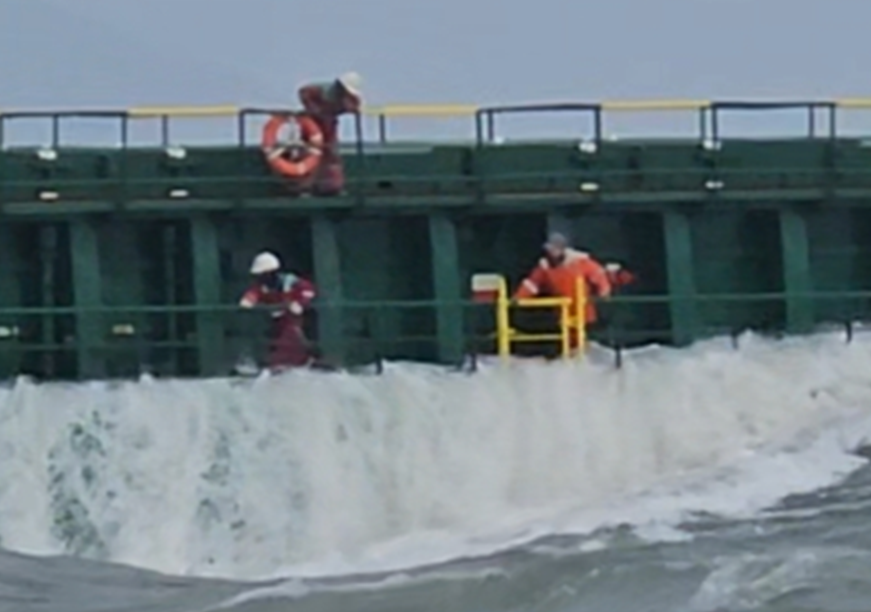
M2494 - Design flaws jeopardize Pilot boarding and crew access
Initial Report
The Pilot Boarding Report read as follows:
“Weather Conditions (first attempt): wind: 33 knots SW; sea: 1.7 – 2.5m swell, Swell breaking over the lower deck, making it inaccessible.
First Attempt – Boarding aborted – The crew was observed standing on the hatch cover above a fixed yellow metal ladder (see attached image), appearing to expect the pilot to board via this structure. No pilot ladder was rigged. The pilotage act was aborted due to the absence of a compliant ladder. The Master was informed, and a second attempt was planned for the following morning.
Second Attempt – Boarding aborted – Weather conditions remained similar to those of the first attempt. The pilot was directed to board near the accommodation area at the vessel’s stern, at the lower deck level. However, this area was repeatedly overtopped by swell, making it unsafe for transfer. Two crew members were again stationed at the top of the fixed vertical metal steps. This arrangement is non-compliant and places both pilots and crew at unnecessary risk. The crew attempted to open a gate amidships as an alternative boarding position, but the vessel was shipping seas on deck and clearly unsafe (see image above).
Third Attempt – Boarding completed – Conditions had eased, and the pilot was able to transfer via the lower deck.
However, several safety issues were observed with the rigged pilot ladder: the ladder was not resting against the ship’s hull, it was secured to the handrail, not to strong points on deck, and
there was an obstruction at the top – the ladder rope did not sit flush with the deck, creating a tripping and entanglement hazard.”
CHIRP Comment
Boarding eventually took place some 48 hrs after the first attempt, and CHIRP commends the strong safety stance taken by the pilots. This report highlights a persistent issue: some vessels continue to be unable to provide safe and compliant pilot transfer arrangements, particularly in adverse weather conditions. In this case, two boarding attempts were aborted due to unsafe setups and the absence of a properly rigged pilot ladder. Crew members were seen using vertical fixed ladders and standing on hatch covers, neither of which is safe or compliant in dynamic sea conditions.
Although the third attempt succeeded in calmer weather, the pilot ladder rigged was still unsafe, with poor securing, gaps between the ladder and hull, and obstructions at the top. This raises serious concerns. Improvised boarding methods, however well-intentioned, expose pilots and crew to unacceptable risk. SOLAS and IMO regulations are not optional; they are the minimum standard.
If the lower deck is the only viable transfer point, this must be clearly stated in the vessel’s pilot card and agreed in advance. It is not helpful to inform the pilot when they are on the bridge about the transfer arrangement. This raises the question: do ports have heavy weather boarding procedures in place, with weather and sea state limits established? Only those conditions that fall within the criteria should be allowed for pilot boarding to take place.
This case reminds us that if a vessel cannot provide a safe and compliant means of pilot transfer under expected conditions, it may not be suitable for pilotage operations without modification. CHIRP will raise this issue with the relevant authorities to explore whether further action or guidance is necessary to prevent recurrence.
The subject of creating a safe lee for boarding was discussed by our Maritime Advisory Board, and this will be published shortly in the ‘Hot Topics’ section of our website.
Key Issues relating to this report
Local Practices – The continued reliance on non-compliant methods implies that unsafe practices may have become informally accepted aboard this vessel.
Complacency – The crew appeared to accept unsafe methods (e.g., fixed ladders, hatch covers) as viable boarding options, indicating the normalisation of non-compliant practices.
Capability – Improper ladder rigging and repeated use of unsafe arrangements suggest a poor understanding of SOLAS Ch V Reg 23 and pilot transfer standards.
Communication – Unclear coordination between the pilot and vessel on boarding points and conditions led to unsafe or aborted attempts.
Key Takeaways
Seafarers – Know the rules, do not improvise. Unsafe boarding improvisations aren’t just non-compliant — they endanger lives. Always use properly rigged pilot ladders, never fixed ladders or hatch covers. If in doubt, stop and escalate the issue.
Managers – Not compliant? Not ready. Vessels must be physically and procedurally capable of safe pilot transfer in the expected weather conditions. Ensure that pilot cards accurately reflect the actual boarding arrangements and that crews are trained to meet SOLAS standards.
Regulators – Unsafe boarding is still too common. Persistent non-compliance shows the need for enforcement, not just guidance. Strengthen oversight of pilot transfer design and onboard practices, and ensure unsuitable vessels are forced to change their poor practices before incidents occur.